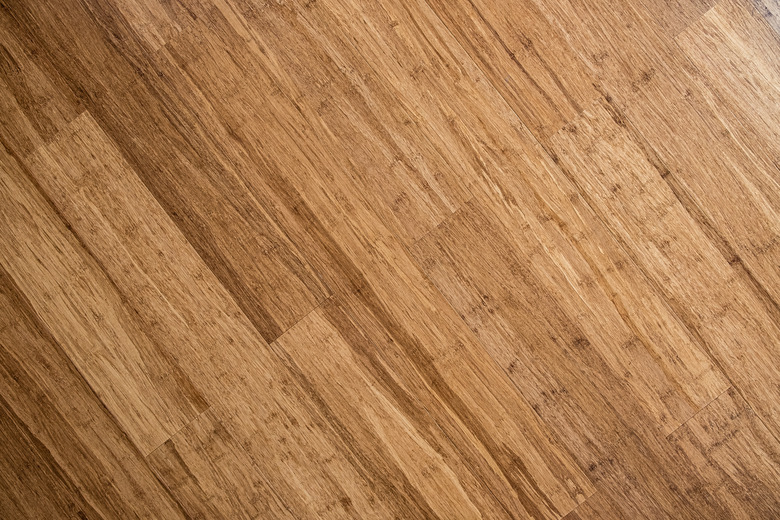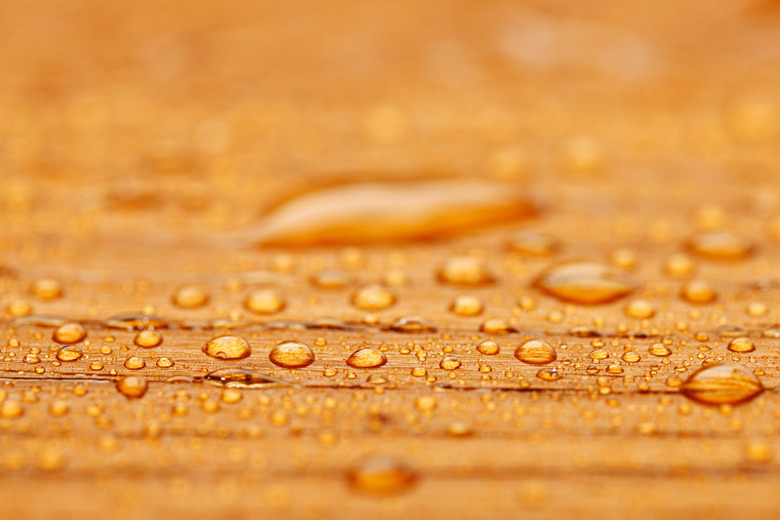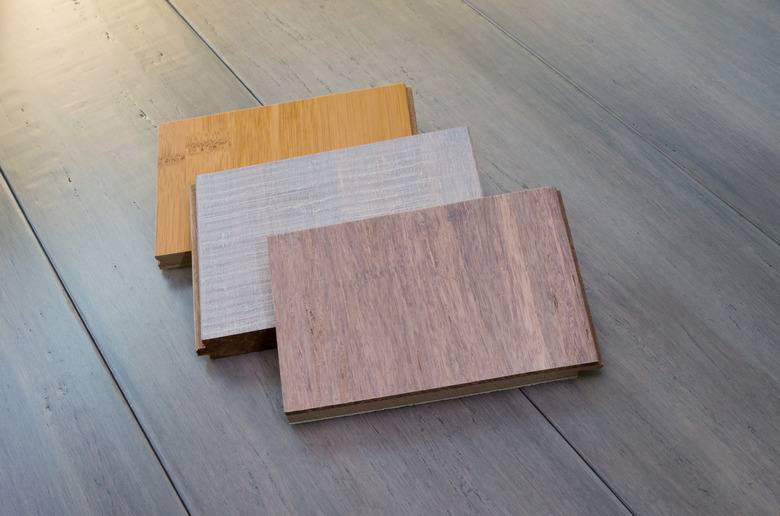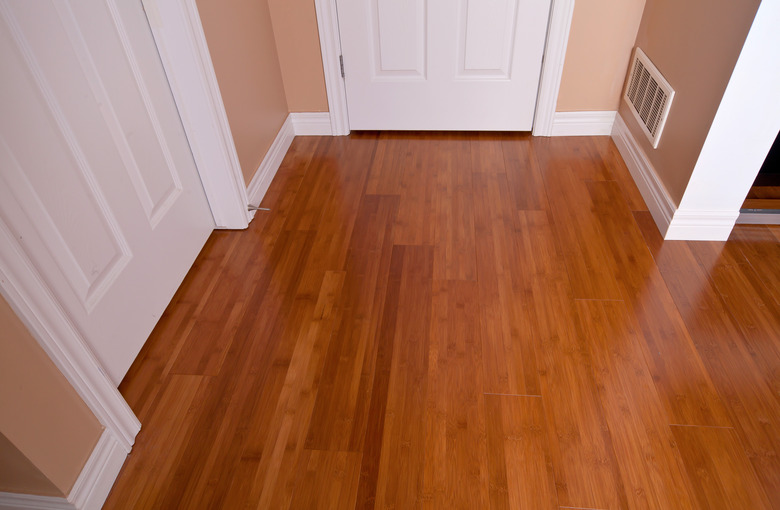Is Bamboo Flooring Waterproof?
While bamboo flooring technically isn't waterproof, it does not readily absorb spills and puddles provided that the liquid is cleaned up in a reasonable amount of time. Bamboo flooring behaves much like the average hardwood floor in that it resists water. No wood or bamboo flooring is truly waterproof despite some marketing materials that use "waterproof" in product descriptions.
Tip
Bamboo flooring is not waterproof, but water poured atop it will not cause damage for at least a few hours or even a full day.
Waterproof vs. Water-Resistant
When it comes to flooring, "waterproof" means water will not penetrate the material no matter how long liquid sits atop it. Ceramic tile, rubber and wood-plastic composite vinyl flooring with a waterproof core are all theoretically waterproof. With flooring such as tile, however, the grout between tiles is not necessarily waterproof. When soaked for a long time, such as if the room floods, the water could soak through the grout and damage the subfloor even though the actual tiles are not harmed. Any "waterproof" flooring is only as waterproof as its seams since water seeps into cracks, gaps and crevices with ease.
Water-resistant flooring does not absorb water provided that the water doesn't sit for hours on end. On the opposite end of the spectrum, the average carpet is not water-resistant and soaks up water with ease. If you spill some water on a wood or bamboo floor, the water pools or beads up and won't penetrate the floor for at least several hours, allowing ample time to clean it up.
If the room floods or a pipe bursts and the flooring stays wet for more than a day, the floor will most likely be ruined, as it will be difficult to remove the moisture that soaks through the planks. Floors made of wood or bamboo, which is really a grass, resist water naturally, while a protective sealant atop the flooring provides even better water resistance.
Bamboo Floors: The Manufacturing Process
Although dried, mature bamboo stalks resemble wood, bamboo flooring is never made from solid bamboo. In its natural form, bamboo stalks are quite susceptible to mold and insect damage. You've probably noticed small amounts of mold or mildew on natural bamboo tiki torches offered in stores, as these issues are quite common. Bamboo floors are more like engineered wood floors than they are solid wood floors. After bamboo is harvested and cut into strips, it undergoes a great deal of processing to form a durable flooring material.
Bamboo strips are boiled to remove starches and sugars that appeal to insects such as termites. This process also makes the material less susceptible to warping when exposed to changes in humidity, according to BuildDirect. Some bamboo is carbonized via steam and pressure, which darkens the material. Carbonized or not, kiln-treating the bamboo removes any remaining moisture.
The bamboo strips are formed into flooring by gluing them together in horizontal staggered stacks or aligning them vertically and then laminating the boards. In some cases, the strips or strands are woven together instead and then compressed and bound together with a resin. The engineered bamboo is milled into flooring planks and then is usually treated with aluminum oxide or another sealant material to make the planks even more resistant to moisture, dents and scratches.
Bamboo Flooring Basics
No matter what the room, bamboo is a great flooring choice for allergy sufferers, as potential allergens are easily swept or vacuumed away. It's much harder to remove allergens and dust from carpets because these fine particles become trapped among the fibers.
Bamboo is generally less expensive than a hardwood floor as well, averaging just under $4 per square foot. Durable hardwood flooring averages around $7.50 per square foot for a moderately hard wood such as teak, cherry or oak. Exotic harder woods can be significantly more expensive, while a softer wood such as pine generally runs $3 to $6 per square foot. All of these prices are for the flooring alone; expect to spend another $4 per square foot to have bamboo or wood flooring professionally installed.
Bamboo Flooring in Kitchens or Bathrooms
Bamboo is an excellent option for a kitchen floor, as it resembles wood and isn't as hard under your feet as ceramic tile. Since it resists moisture and liquids, it usually won't stain provided that spills are cleaned up right away. Bamboo and other hard-floor surfaces are a much better choice than carpeting in a kitchen since dropped ingredients are easy to sweep or wipe up.
Even though bamboo resists moisture quite well, it isn't a good idea for bathrooms, especially those used by children. A frequently used bathtub often means puddles and excessive moisture near the outside of the tub, especially with children, teens or others who may not make a conscious effort to wipe up the floor after a bath.
If not wiped up right away, this moisture could penetrate bamboo flooring as well as any areas that aren't properly caulked around the tub. If householders primarily use the shower, the floor likely doesn't get as wet, so bamboo could be an option. In a secondary or guest bathroom, bamboo is more suitable, as the floor offers the look of wood with little maintenance required.
Some bamboo flooring retailers such as Ambient Bamboo Floors list the material as waterproof for up to 30 hours. This just means that the flooring prevents water from penetrating for up to a day or so, but eventually, moisture soaks through, causing the bamboo to warp. If the bamboo gets completely saturated, there might be water damage and the subfloor could get wet as well, which means it may need to be partially replaced.
Bamboo Flooring in a Basement
While hardwood floors generally aren't recommended for basements due to potentially damp conditions and frequent changes in humidity, bamboo flooring holds up quite well in a basement that doesn't typically flood or show signs of moisture penetration during rainy weather.
Bamboo resists moisture a bit better than other flooring options, but damage is likely if the basement floods or a plumbing issue in the laundry room dumps water all over the floor. In basements that are so damp that the floor often feels wet to the touch, mold or mildew may occur. The same holds true for virtually any flooring in extremely humid environments.
Ask your flooring retailer for recommendations about a moisture barrier for basement use. Some bamboo floor manufacturers suggest an underlayment that provides moisture resistance and cushioning all in one product. The best underlayment for your bamboo floor varies depending on the particular flooring product and the typical moisture levels in your basement.
If your basement seems damp virtually all the time, even during dry weather, a dehumidifier is a good idea, especially when paired with fans or even ventilation. Aim to keep the basement's relative humidity below 50 percent, which may be tricky to do in summer without a dehumidifier or air conditioner. When basement humidity levels soar, so does the chance for harmful mold growth, which could exacerbate asthma and allergy symptoms. Opening basement windows on days that aren't humid could also help reduce the moisture level below grade. Repairing leaky pipes and cracks in your home's foundation also helps to cut down on unwanted basement moisture.
References
- Ambient Bamboo Floors: Is Bamboo Flooring Waterproof? Can I Put It In My Kitchen?
- McSwain Carpets & Floors: Remodeling Your Kitchen or Bathroom? 10 Reasons to Consider Cork or Bamboo Floors
- Flooring Inc.: The Best Waterproof Flooring Options
- Gold Eagle: Are Hardwood Floors Waterproof?
- BuildDirect: How Is Bamboo Flooring Made
- HomeAdvisor: How Much Does Bamboo Flooring Cost?
- HomeAdvisor: How Much Does Hardwood Flooring Cost?
- Ambient Bamboo Floors: Can I Install Bamboo Flooring in a Basement?
- American Family Insurance: What Should Your Basement Humidity Level Be?



